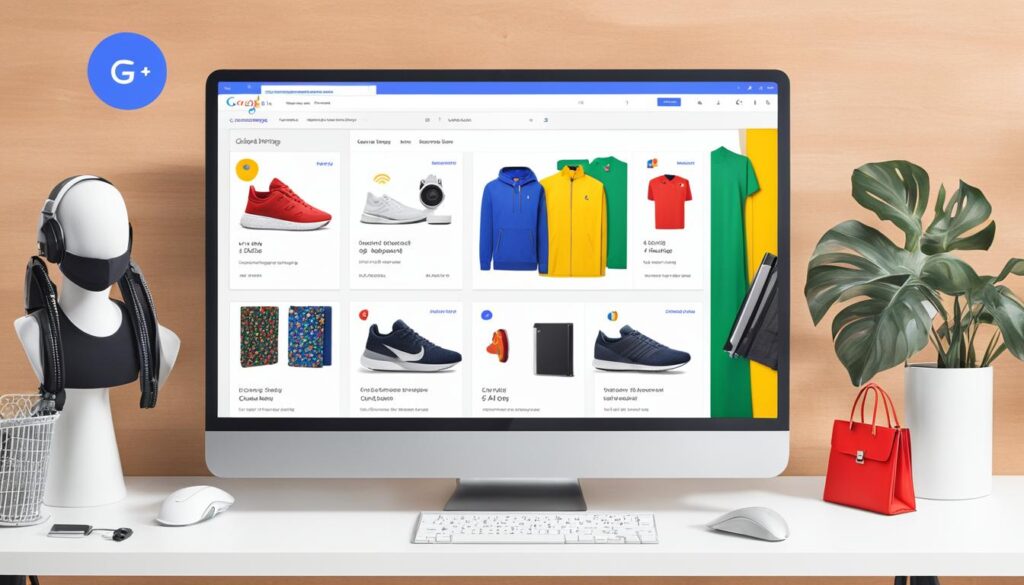
Welcome to my article on how to boost ecommerce sales by implementing effective SEO strategies. In today's competitive online marketplace, having an optimized online store is crucial for driving traffic and increasing conversions. By utilizing the right Ecommerce SEO strategies, you can maximize your online store's potential and achieve higher sales.
Implementing these strategies starts with optimizing your product listings on Google Shopping. With millions of products available online, standing out from the competition is essential. By targeting the right audience and utilizing data analytics, you can gain valuable insights that will help you refine your marketing approach and increase sales.
Understanding Google Shopping is key to leveraging it for ecommerce success. It is an online service that acts as both an advertising platform and a comparison-shopping engine. By setting up a Google Merchant Center account, you can optimize your product listings, making them more visible to potential customers. With clear images, detailed descriptions, and relevant keywords, you can enhance your product visibility and drive more sales.
Key Takeaways:
- Ecommerce SEO strategies are essential for boosting sales and driving traffic to your online store.
- Optimizing product listings on Google Shopping increases product visibility and drives conversions.
- Understanding your target audience and leveraging Google's targeting options are crucial for effective Google Shopping ads.
- Data analytics tools provided by Google help optimize ads for better performance.
- Continuous learning and staying informed about industry trends are essential for long-term success in the ever-evolving world of ecommerce.
Understanding Google Shopping for Ecommerce Success
Google Shopping is an online service that combines the functionalities of an advertising platform and a comparison-shopping engine. It provides users with the ability to search for, compare, and shop for physical products offered by various retailers. By leveraging Google Shopping, ecommerce businesses can enhance their product visibility and drive sales.
The first step in harnessing the power of Google Shopping is setting up a Google Merchant Center account. This allows sellers to upload their product data and create product listings that will be shown on Google Shopping. By optimizing these listings with clear images, detailed descriptions, and relevant keywords, you can significantly improve product visibility and increase the chances of attracting potential customers.
Google Shopping serves as a powerful advertising platform where sellers can promote their products to a wide audience. This online service enables retailers to showcase their offerings alongside other similar products, allowing potential customers to compare prices, features, and reviews. By being present on this comparison-shopping engine, you can tap into a large pool of potential buyers and increase your chances of making sales.
"Google Shopping is a game-changer for ecommerce businesses. The platform provides unmatched exposure to a broad customer base, helping retailers to expand their reach and drive revenue."
Moreover, Google Shopping provides valuable insights and analytics that sellers can utilize to refine their advertising strategies. Through data analytics tools provided by Google, you can gain a deeper understanding of how your ads are performing in terms of clicks, impressions, and conversions. This enables you to make data-driven decisions and optimize your ads for better results.
Key Benefits of Google Shopping for Ecommerce:
- Broaden product visibility by appearing in search results alongside similar products
- Attract potential customers through eye-catching product images and compelling descriptions
- Maximize sales opportunities by reaching a wider audience
- Utilize data analytics to gain insights and optimize ad performance
With Google Shopping, ecommerce businesses have the opportunity to increase their product visibility, attract more customers, and drive sales. By understanding the platform, optimizing product listings, and utilizing data analytics, you can leverage this powerful tool to achieve ecommerce success.
Targeting the Right Audience with Google Shopping Ads
Understanding the target audience is vital for running effective Google Shopping ads. By utilizing Google's targeting options, such as location and search history, you can reach potential customers who are more likely to convert. Targeting the right audience increases the chances of your ads being seen by individuals who have a genuine interest in your products, leading to higher conversion rates and improved ROI.
Google provides a range of targeting options to help you refine your audience selection:
- Location: Specify the geographic regions where you want your ads to appear. If your target audience is specific to certain locations, this option allows you to focus your efforts on those areas.
- Search History: Take advantage of users' search history within Google's ecosystem. By targeting individuals who have previously shown interest in products or services similar to yours, you can increase the likelihood of capturing their attention and making a sale.
By tailoring your advertising approach based on your target audience's characteristics, behaviors, and preferences, you can optimize your Google Shopping ads for better performance. This targeted approach minimizes the wastage of ad spend on irrelevant audiences and maximizes the chances of reaching potential customers who are more likely to convert.
Once your Google Shopping ads are up and running, it's crucial to monitor their performance closely. Keep track of metrics such as clicks, impressions, conversions, and conversion rates to evaluate the effectiveness of your ads and make data-driven decisions for continual improvement. Analyzing these metrics provides valuable insights into the success of your targeting efforts and helps you make informed adjustments to your campaign, further optimizing results.

Quote:
"Targeting the right audience is like aiming at a bullseye. By narrowing down your focus, you increase your chances of hitting the mark and achieving higher conversion rates."
Leveraging SEO and Analytics for Google Shopping Success
When it comes to SEO strategies, many ecommerce businesses focus solely on optimizing their website. However, SEO can also play a crucial role in maximizing product visibility and driving sales on Google Shopping listings. By incorporating relevant keywords in product titles and descriptions, sellers can increase their chances of appearing in search results and attracting potential customers.
But SEO is just the beginning. To truly optimize ads and achieve Google Shopping success, sellers must also harness the power of data analytics. Google provides powerful data analytics tools that allow sellers to gain insights into their ad performance and make data-driven decisions. By analyzing metrics such as clicks, impressions, and conversions, sellers can identify areas for improvement and optimize their ads for better results.
Staying updated on industry trends and competitors' strategies is crucial for staying ahead in the competitive Google Shopping space. By continuously monitoring the market and making informed adjustments to their SEO and advertising strategies, sellers can maintain a competitive edge and drive success in the ever-evolving ecommerce landscape.
Proven SEO Strategies for Google Shopping Success
- Keyword research: Conduct thorough research to identify relevant keywords for your product listings. Use tools like Google Keyword Planner and SEMrush to discover high-volume, low-competition keywords that align with your target audience.
- Optimize product titles: Incorporate your target keywords naturally into your product titles to improve visibility in search results. Ensure that the titles accurately describe your products and are compelling enough to catch the attention of potential buyers.
- Write persuasive descriptions: Craft unique and compelling product descriptions that highlight the key features and benefits of your products. Incorporate relevant keywords naturally while providing valuable information to potential buyers.
- Use high-quality images: Visual appeal is crucial in driving conversions. Use high-resolution images that showcase your products in the best possible light. Optimize the image file names and alt tags with relevant keywords to enhance search visibility.
- Analyze and optimize: Regularly analyze the performance of your Google Shopping ads using Google Analytics. Identify trends, track conversions, and make data-driven optimizations to improve ROI.
By implementing these SEO strategies and leveraging data analytics tools, ecommerce businesses can optimize their Google Shopping listings and improve their chances of success in the competitive online retail landscape.

| Benefits of Leveraging SEO and Analytics for Google Shopping | SEO Strategies | Data Analytics |
|---|---|---|
| Improved product visibility in search results | Optimized product titles and descriptions with relevant keywords | Insights into ad performance metrics like clicks, impressions, and conversions |
| Increased click-through rates and conversions | High-quality images and compelling product descriptions | Identification of trends and opportunities for optimization |
| Competitive advantage in the Google Shopping space | Continuous monitoring and adjustment of SEO strategies | Data-driven decision-making for ad optimization |
Conclusion
Google Shopping provides ecommerce businesses with a powerful platform to expand their reach and boost sales. By gaining a deep understanding of the platform, optimizing product listings, targeting the right audience, and utilizing data analytics, sellers can maximize their success in this competitive marketplace.
However, in the fast-paced world of ecommerce, it is crucial for businesses to stay informed and adaptable. Continuous learning, testing, and evolving strategies are key to long-term success. To stay ahead of the game and thrive in the digital marketplace, it is important to stay connected with resources like Daily Posts, where you can access valuable insights and industry updates.
Achieving ecommerce success through Google Shopping requires a combination of knowledge, strategy, and flexibility. By implementing effective SEO practices, leveraging Google Shopping's features, and staying informed about the latest trends and techniques, you can establish your brand, drive sales, and stay one step ahead of the competition.
FAQ
What are some effective SEO strategies for increasing ecommerce sales?
Some effective SEO strategies for increasing ecommerce sales include optimizing product listings on Google Shopping, targeting the right audience, and using data analytics.
What is Google Shopping and how can it help with ecommerce success?
Google Shopping is an online service that combines elements of an advertising platform and a comparison-shopping engine. It allows users to search for, compare, and shop for physical products offered by different retailers. Utilizing Google Shopping can enhance product visibility and drive sales for ecommerce businesses.
How can I target the right audience with Google Shopping ads?
Google offers a wide range of targeting options for Google Shopping ads, including location and search history. By tailoring your advertising approach based on these factors, you can reach potential customers and achieve higher conversion rates.
How can I leverage SEO and analytics for success with Google Shopping?
SEO can be applied to Google Shopping listings by incorporating relevant keywords in product titles and descriptions. Data analytics tools provided by Google enable sellers to gain insights and optimize their ads for better performance.
How can I ensure ecommerce success with Google Shopping?
To ensure ecommerce success with Google Shopping, it is important to stay informed, adapt to industry trends, and continuously test and evolve strategies. Keeping up with resources like Daily Posts can help you stay ahead of the game and thrive in the digital marketplace.











